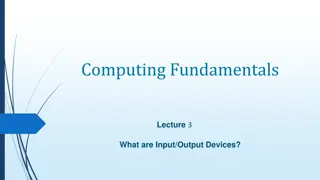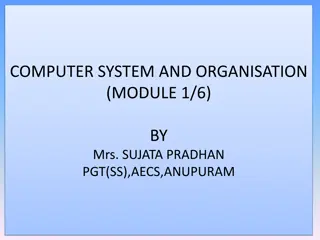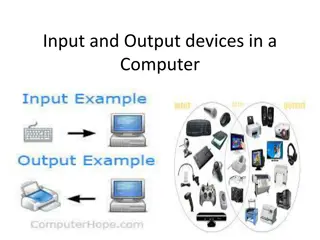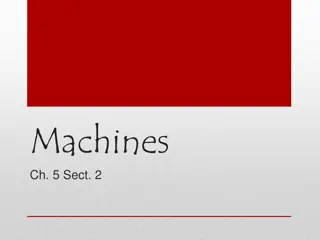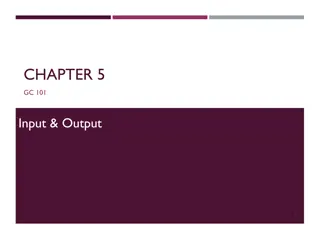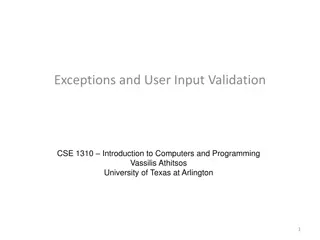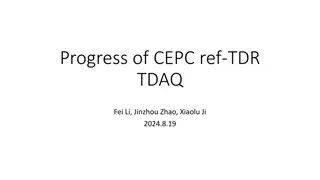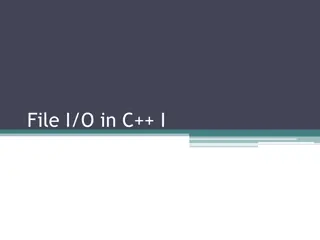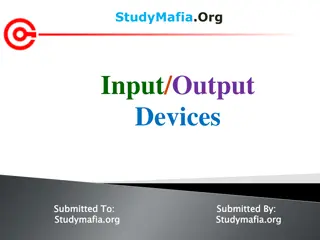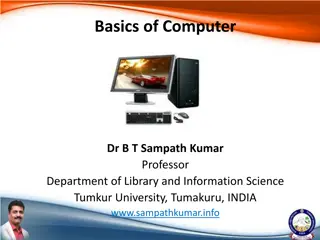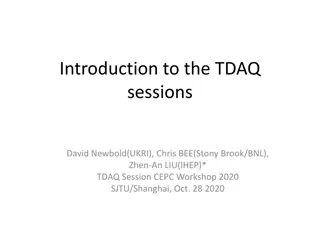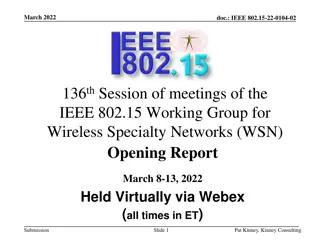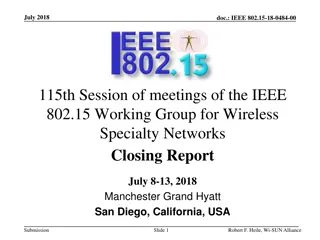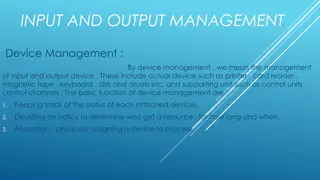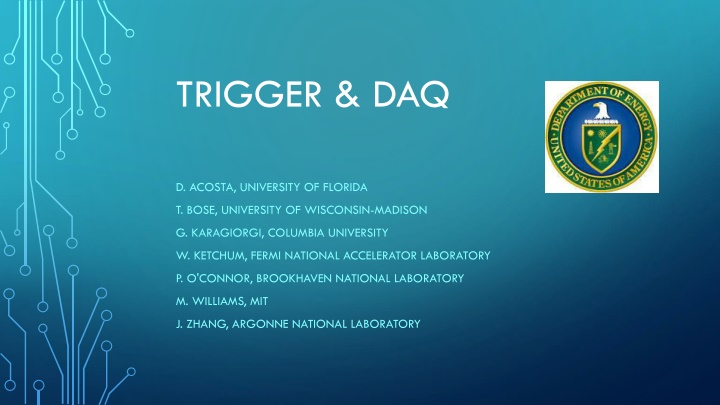
TDAQ BRN Working Group - Community Input and Future Developments
The Trigger & DAQ BRN Working Group has been actively gathering community input related to R&D priorities since September. They are exploring revolutionary solutions such as trigger-less readout systems and high-performance software-based triggers to address the challenges in large-scale HEP experiments. The group is also focusing on advancements in streaming DAQ, machine learning applications, and alternative hardware technologies. Stay updated on their progress and contribute to the discussions in the upcoming townhall meetings and community events.
Download Presentation

Please find below an Image/Link to download the presentation.
The content on the website is provided AS IS for your information and personal use only. It may not be sold, licensed, or shared on other websites without obtaining consent from the author. If you encounter any issues during the download, it is possible that the publisher has removed the file from their server.
You are allowed to download the files provided on this website for personal or commercial use, subject to the condition that they are used lawfully. All files are the property of their respective owners.
The content on the website is provided AS IS for your information and personal use only. It may not be sold, licensed, or shared on other websites without obtaining consent from the author.
E N D
Presentation Transcript
TRIGGER & DAQ D. ACOSTA, UNIVERSITY OF FLORIDA T. BOSE, UNIVERSITY OF WISCONSIN-MADISON G. KARAGIORGI, COLUMBIA UNIVERSITY W. KETCHUM, FERMI NATIONAL ACCELERATOR LABORATORY P. O'CONNOR, BROOKHAVEN NATIONAL LABORATORY M. WILLIAMS, MIT J. ZHANG, ARGONNE NATIONAL LABORATORY
TDAQ BRN WORKING GROUP The Trigger & DAQ (TDAQ) BRN working group has been active since September in gathering community input related to TDAQ R&D priorities TDAQ Google Form: https://forms.gle/jZ1aqDTm2PtCvcJT9 Survey to collect input specifically from the TDAQ community A very brief summary later in this talk If you have not provided input yet and would like to, there is still time! TDAQ Community meeting held on Tues, Dec 3rd(via Zoom) https://agenda.hep.wisc.edu/event/1430/overview Video recording here Several interesting presentations, good discussion The townhall tomorrow will be another venue for providing input TDAQ BRN WORKING GROUP 12/8/19 2
TDAQ R&D GRAND CHALLENGE Streaming DAQ or Can a trigger-less readout and DAQ system be a common solution for future large-scale HEP experiments ? Revolutionary! Will provide unprecedented flexibility/possibilities Read out data from experiments at natural rate (w/o hardware trigger) First strides being made by LHCb and ALICE during Run 3 (2021+) Two-stage approach: (i) processing the data during data taking for a first data reduction and (ii) storing it to an on-site disk-buffer for a second processing when there is no beam. Huge data rates (up to 40 Tbit/s) alternative hardware technologies (GPUs) For a common solution and for the next generation experiments, require high bandwidth technology, data compression, on-detector intelligence, and high performance software-based triggers TDAQ BRN WORKING GROUP 12/8/19 3
STREAMING DAQ R&D Radiation-hardened, high bit-rate optical transmitter modules support data rates of 10 Gbps, 25 Gbps or higher per link Radiation-hardened for use in a high radiation environment, such as the innermost area of the tracking detector for future HEP collider experiments. Low-cost Optical links management: incl. how to monitor links and predict errors R&D towards wireless data transmission (revolutionary) Data compression and on-detector intelligence Development of a scalable DAQ system to enable the transition from custom hardware to commodity networking and computing as much as possible Alternative hardware technologies instead of traditional CPU computing farms: GPUs, FPGAs, CPU-FPGAs, GPGPUs, FPGAs with AI cores Fast machine learning for improving performance of software-based triggers TDAQ BRN WORKING GROUP 12/8/19 4
MACHINE LEARNING Essential for data reduction and data processing Both with and without streaming DAQ instrumentation R&D needed for low latency, high data volume ML algorithms to achieve unprecedented data reduction In many cases need custom designs for extremely low, sub-microsecond latency requirements On-detector algorithms need to work in extreme environments (low-power, cryogenic, high-radiation and infrastructure) Off detector: Integrate heterogenous computing platforms TDAQ BRN WORKING GROUP 12/8/19 5
TOOLS In parallel, develop tools that leverage new technology Tools to make use of new FPGA technologies, or more generally heterogeneous computing hardware, for real-time and power constrained applications Tools such as hls4ml that allow physicists to prototype ML algorithms for both firmware feasibility and physics performance without extensive Verilog/VHDL experience greatly decreasing the time for algorithm development cycles while preserving engineering resources. Automated, self-running DAQ systems Fast collection and processing of conditions data to detect and respond to faults in order to improve data collection efficiency for increasingly complex detectors E.g. anomaly detection, transient detection algorithms, neuromorphic algorithms Could take advantage of AI TDAQ BRN WORKING GROUP 12/8/19 6
PIXEL DETECTOR FOR TRIGGERING ? Challenges for reading out a pixel detector at a reasonable rate for trigger Future EF experiments will require highly granular detectors, yielding large data rates A tracking trigger, or b-tag trigger, at Level-1 will require incorporation of pixel data, improve primary vertex reco, provide vertex separation for pileup mitigation Requires high bandwidth data links (perhaps wireless), rad-hard, low power, low material; next generation ASICs w/ local processing for data reduction, more logic density System level complexity (e.g. if using region-of-interest readout for reducing bandwidth) TDAQ BRN WORKING GROUP 12/8/19 7
PRECISION TIMING & SYNCHRONIZATION Precision timing in trigger, and precision synchronization Cosmic and Intensity Frontier experiments rely on self-generating and distributing a master timing reference over large distances (km s, even 1000s of km s for multi- messenger) Energy Frontier experiments will incorporate highly granular precision timing detectors to handle high pileup, requiring precise timing to 10 s of ps. Use for real-time trigger faces same challenges as for pixel trigger 4D tracking with spatial and timing readout Incorporate precision timing with spatial readout in real-time applications to improve tracking performance in high pileup conditions in EF experiments Rad-hard high bandwidth data links, high bandwidth wireless transmission Fundamental for future EF hadron collider experiments TDAQ BRN WORKING GROUP 12/8/19 8
SOME INTERCONNECTION EXAMPLES, ENERGY FRONTIER EXPERIMENTS Streaming DAQ Performant Trigger Pixel readout 4D Tracking Fast ML Precision timing High bandwidth links New tools and technologies TDAQ BRN WORKING GROUP 12/8/19 9
BRN TDAQ SURVEY RESULTS We conducted a community survey during November 2019 31 responses as of Dec 8th, 2019, from cross- experimental/frontier HEP community Thank you to many of you who provided input! TDAQ BRN WORKING GROUP 12/8/19 10
Q1: TOP TDAQ CHALLENGES THE HEP COMMUNITY WILL BE FACING IN 10+ YEARS, THINKING ABOUT FUTURE- GENERATION HEP PROJECTS A list of identified challenges was provided for responders to select all that apply Other responses included: Visualization technology to improve uptime and reduce operational support (related to Run Control) Energy economy in machine learning or computing systems Cooling Data links for challenging environments (related to Hardware) Data Quality Monitoring TDAQ BRN WORKING GROUP 12/8/19 11
Q2: RESPONDERS WERE ASKED TO ELABORATE ON THE CHALLENGES COLLECTIVELY IDENTIFIED IN Q1 In summary, the prevalent message was that nearly every future experiment or upgrade will face increasingly high rates that outpace the reduction in storage/processing cost over time, and this will require the combination of streaming DAQ architectures with preprocessing which allows for efficient online analysis of the data. This in turn will rely on more effective algorithms and architectures, better use of timing information, etc. Storage was identified as merely a cost-issue. TDAQ BRN WORKING GROUP 12/8/19 12
Q3: RESPONDERS WERE ASKED TO INDICATE WHETHER ANY OF THE CHALLENGES IDENTIFIED IN Q1 APPLY TO A CURRENT/FUTURE EXPERIMENT OR FRONTIER A list of identified challenges was provided for responders to select all that apply Responses also broken down by frontier and experiment TDAQ BRN WORKING GROUP 12/8/19 13
Q4: RESPONDERS WERE ASKED TO IDENTIFY WHAT THEY THOUGHT WERE THE MOST PROMISING AREAS OF R&D FOR PROVIDING SOLUTIONS TO ABOVE CHALLENGES Common themes identified in responses: Move of (traditionally) software-based processing into front-end, hardware Integrated sensor and readout/processing technology Real-time ML/DL implementation with hardware acceleration Parallelization through new technologies/architectures High-bandwidth, low-power wireless links New perspectives included: New approaches to information flows Use of ML for data quality monitoring TDAQ BRN WORKING GROUP 12/8/19 14
Q5: RESPONDERS WERE ASKED TO IDENTIFY OTHER AREAS OF R&D THAT, ALTHOUGH NOT TARGETING A PARTICULAR CHALLENGE, COULD BE TRANSFORMATIONAL FOR HEP TDAQ Received numerous responses; selected list deviating from lists provided: Standardizing the electronics platform, with a more up to date, longer term, user- friendly option than CAMAC, VME, MicroTCA, ATCA Higher-throughput multi-purpose I/O boards that can be used across the field, and interfaces with hardware (e.g. GPUs) for sophisticated data processing Image-analysis-based triggering (without the need of object reconstruction) Autonomous detectors; use of ML more broadly, e.g. error detection, data taking monitoring, trigger rate monitoring Timing detector technologies to perform per-hit-timing in a cost effective manner to alleviate pile-up problems Wireless readout; fiber transmission of power (reducing heat load due to copper in cryogenics, provides high voltage isolation) Manipulation of experimental data in a new form TDAQ BRN WORKING GROUP 12/8/19 15
ANY QUESTIONS OR COMMENTS ? TDAQ related discussions will continue in the parallel sessions at this workshop and during the townhall discussions We welcome input from you via the google form (or email, in person ) https://forms.gle/jZ1aqDTm2PtCvcJT9 A draft, intermediate version of our report is available https://agenda.hep.wisc.edu/event/1430/material/4/0.pdf We welcome your input, comments and suggestions. TDAQ BRN WORKING GROUP 12/8/19 16

